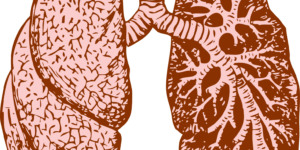A 3D model for CF could save lives.
Cystic Fibrosis (CF) affects around 10,500 people in the UK. The genetic mutation that causes CF leads to the build-up of thick mucus in the airways of the lung. This mucus cannot be cleared without physiotherapy, and people with CF are vulnerable to respiratory infections that are difficult to treat with antibiotics. Various different microorganisms can coexist within the mucus and cause infection.
To study infections of the CF lung we need accurate laboratory models. The problem is that bacteria behave differently when grown in artificial models, compared to inside a living body. Historically, scientists have overcome this by using live animal models. But, apart from obvious ethical implications, animal models are complex, expensive and, in the case of CF, not very accurate. Pulmonary infection symptoms in a CF mouse are quite distinct from those seen in humans. In mice, lung infection with Staphylococcus aureus rapidly leads to the formation of abscesses (1); a rare phenomenon in people with CF. S. aureus is often found in the sputum of people with CF but doctors debate whether it actually causes lung damage. In fact, clinicians are starting to question if using antibiotics to clear S. aureus from the lung might do more harm than good (2, 3).
Some larger animals have respiratory systems more closely related to humans. Pig lungs in particular have similar anatomy to our own. Thankfully, we do not have to experiment with live pigs, instead we use pig lungs that are a waste product of the meat industry, and usually only used for pet food. We cut small cubes from the airways and place these in plastic dishes surrounded by artificial mucus, with a similar chemical composition to mucus in CF lungs. Using this method, we are able to accurately model infections caused by Pseudomonas aeruginosa, a bacterium which infects most adults with CF, and is linked with worsening symptoms (4). We are also investigating how S. aureus might live in the lungs of people with CF. In our model it does not damage lung tissue or cause the abscesses seen in mice.
We want to explore different bacterial species in the model in more detail. Might S. aureus really colonise mucus without triggering harmful symptoms? We also want to study how different bacteria interact. For example, even if S. aureus is not harmful alone, does it encourage more dangerous bacteria, such as P. aeruginosa, to grow? Or, conversely, could the presence of S. aureus protect the lung? The answers to these questions will have important implications for future clinical treatment.
As well as understanding infection, an accurate yet cheap lung model could provide a simple way to test drug delivery and efficacy –speeding up the development of treatments for a range of respiratory diseases. Or, it might help us understand the effect of air pollution or e-cigarette vapour on lungs. There are multiple research uses, ultimately, we have shown that, by using a waste product from the meat industry, a realistic alternative to live animal models is possible, affordable and sustainable.
References
1. Bragonzi A. Murine models of acute and chronic lung infection with cystic fibrosis pathogens. Int J Med Microbiol. 2010 Dec;300(8):584-93.
2. Ratjen F, Comes G, Paul K, Posselt HG, Wagner TO, Harms K. Effect of continuous antistaphylococcal therapy on the rate of P. aeruginosa acquisition in patients with cystic fibrosis. Pediatr Pulmonol. 2001 Jan;31(1):13-6.
3. Smyth AR, Rosenfeld M. Prophylactic anti-staphylococcal antibiotics for cystic fibrosis. Cochrane Database Syst Rev. 2017 Apr 18;4:Cd001912.
4. Harrison F, Diggle SP. An ex vivo lung model to study bronchioles infected with Pseudomonas aeruginosa biofilms. Microbiology. 2016 Oct;162(10):1755-60.
© Esther Sweeney

This work is licensed under a Creative Commons Attribution-NonCommercial 4.0 International License.
Featured Image by Clker-Free-Vector-Images from Pixabay

Leave a Reply